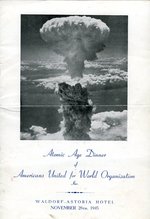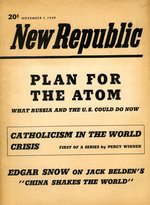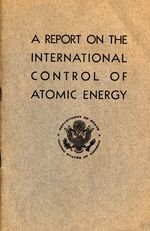Opinion on nuclear policy in the U.S. was divided primarily into two camps. Some, led by Secretary of State James B. Byrnes, believed that atomic energy was America's only hope against the Soviet Union's massive land army. To forego that advantage, they claimed, would be disastrous. Conversely, there were others who felt that the U.S.'s monopolization of nuclear technology would only serve to hinder diplomacy with Moscow and eventually force the USSR to develop its own nuclear arsenal. Secretary of War Henry L. Stimson, one of the first American officials to be aware of the atomic bomb program, believed the bomb could only harm U.S. relations with Russia.
President Truman was caught between these two camps, each with its own network of powerful supporters, and could not provide a recommendation to the U.N. until his own country had reconciled some of its differences. In response to this conflict of ideologies, Truman formed a committee, assigning Under Secretary of State Dean Acheson to head it.1 Acheson, in turn, called upon several scientists and military officials including James Conant, Vannevar Bush, and General Leslie Groves - three men involved in the Manhattan Project.2 For technical expertise, Acheson asked nuclear scientists David Lilienthal and Robert Oppenheimer to join the committee as well, appointing Lilienthal chairman.
The committee needed to devise a treaty that would be both practical and palatable for the Soviets. In February 1946 Robert Oppenheimer suggested that an international body be created to govern the production of all raw radioactive material. This organization would be responsible for treating the material in such a way as to render it unusable for weapons. The international body would then distribute the material for peaceful application. The Acheson Committee was impressed by the idea and began drafting a comprehensive plan based on Oppenheimer’s contribution.
The Report on the International Control of Atomic Energy was submitted to the U.S. State Department on March 16, 1946.3 Often referred to as the Acheson-Lilienthal Report, the document recommended against attempts to police nuclear research through surveillance tactics. Instead, the report advocated the creation of an Atomic Development Authority. Like the organization in Oppenheimer’s plan, the ADA was meant to control mining and refinery activities, distribute nuclear materials among nations, and facilitate the international sharing of information regarding the peaceful uses of atomic energy.
The plan, however, was not without its opponents. One such opponent was Bernard Baruch, the United States representative to the UNAEC, who offered an alternative. The Baruch Plan required a branch of the U.N. to extensively police mines and refineries responsible for the production of radioactive materials. This agency would specify production, safety, and security processes, engage in routine inspections of manufacturing sites, and actively work to prevent the illegal accumulation of weapons-grade radioactive materials. The U.N. would also be responsible for taking action against any nation found to be in violation of the agreement. The U.S., under Baruch's plan, would disassemble its nuclear stockpile only once the organization was created and functioning with the approval of all U.N. participants.
In June 1946 the Baruch Plan was presented to the UNAEC and passed by the Commission with little objection.4 5 A UNAEC report supporting the plan was then transmitted to the U.N. General Assembly and Security Council for approval on December 31, 1946.6
While the U.S. and other western powers championed the proposal, the Soviet Union was unimpressed. In the view of Russian diplomats, the U.N. was dominated by the U.S. and its allies and was unfairly weighted against the Russian agenda. As a result, Soviet officials suggested that the U.S. disarm prior to further negotiations. The U.S. refused and by early 1948 the Soviet Union had discontinued talks on the subject.
By the fall of 1948 Truman had committed to use of the bomb in the event of a war with Russia. Through the winter of 1948 and much of 1949, tensions between the U.S. and USSR grew. By the summer of 1949 the UNAEC had become inactive, though it was not until 1952 that the program was fully decommissioned.
On September 29, 1949, the Soviet Union exploded Joe I in its first atomic weapons test. The U.S. was stunned - it had not been prepared to deal with a nuclear nation so aggressively opposed to American ideology. In order to maintain nuclear dominance, it seemed clear that the U.S. would need a more powerful weapon. Less than a month later, steps were taken to increase uranium and plutonium production in the U.S.
Notes
- 0470. Acheson, Dean. Present at the Creation. My Years in the State Department. New York: Norton, 1969. E744 .A21. Return to text ↑
- 0494. Bush, Vannevar. Modern Arms and Free Men. A Discussion of the Role of Science in Preserving Democracy. New York: Simon and Schuster, 1949. U42 .B8. Return to text ↑
- 0474. Barnard, Chester I., J.R. Oppenheimer, David E. Lilienthal, et al. A Report on the International Control of Atomic Energy. Washington, D.C.: USGPO, March 16, 1946. UF767 .U58 1946. Return to text ↑
- 0476. Baruch, Bernard M., Office of. Scientific Information Transmitted to the United Nations Atomic Energy Commission by the United States Representative. Volume I. June 14, 1946. New York, 1946. QC173 .S3 1946. Return to text ↑
- 0556. U.S. Department of State. "United States Atomic Energy Proposals." Statement of the United States Policy on Control of Atomic Energy as Presented by Bernard M. Baruch, Esq., to the United Nations Atomic Energy Commission June 14, 1946. Washington, D.C.: U.S. Dept of State, 1946. HD9698.A2 B33. Return to text ↑
- 0545. United Nations Atomic Energy Commission. First Report. . . to the Security Council December 31, 1946. Washington, D.C.: USGPO, 1947. Return to text ↑



